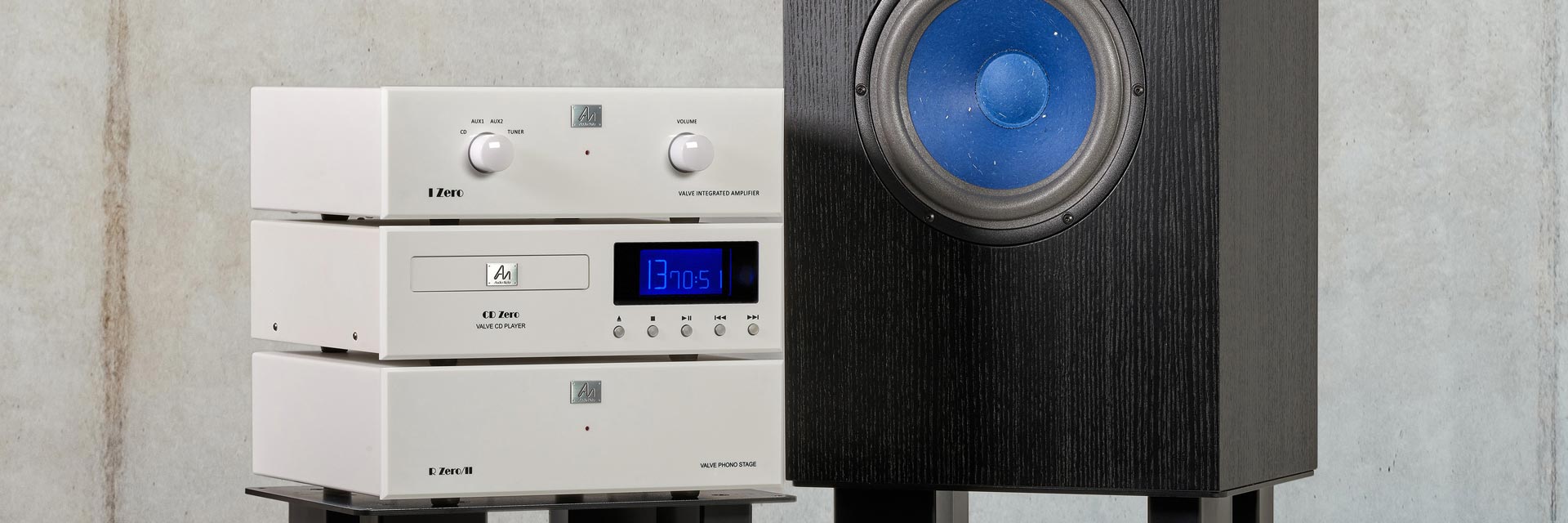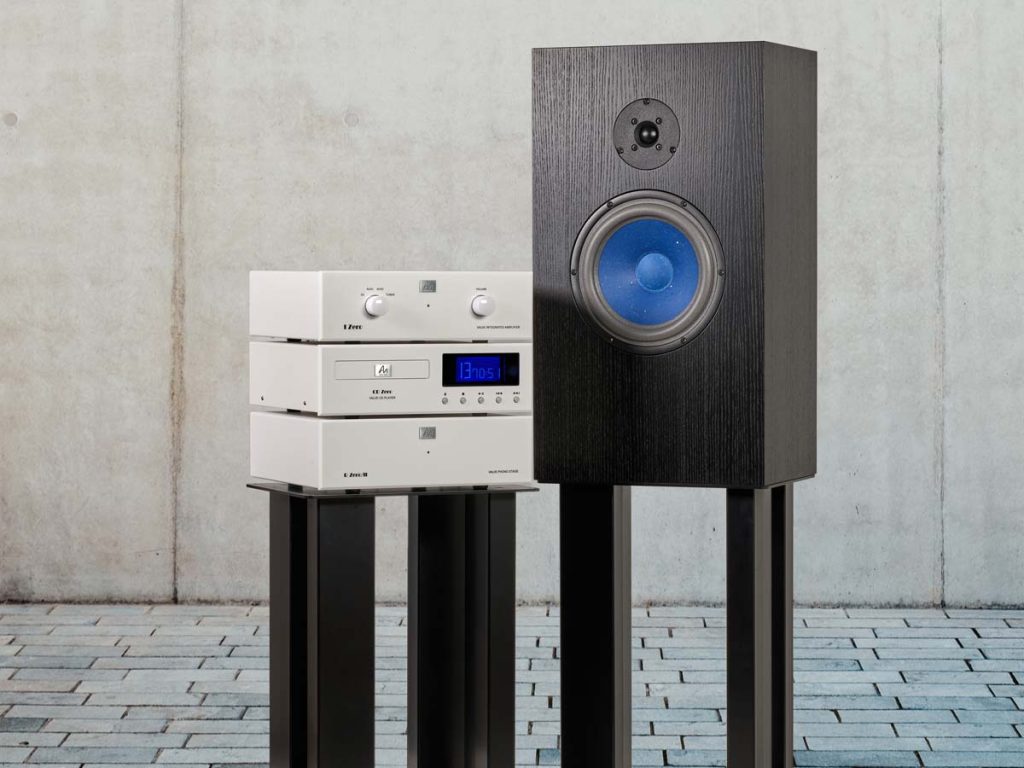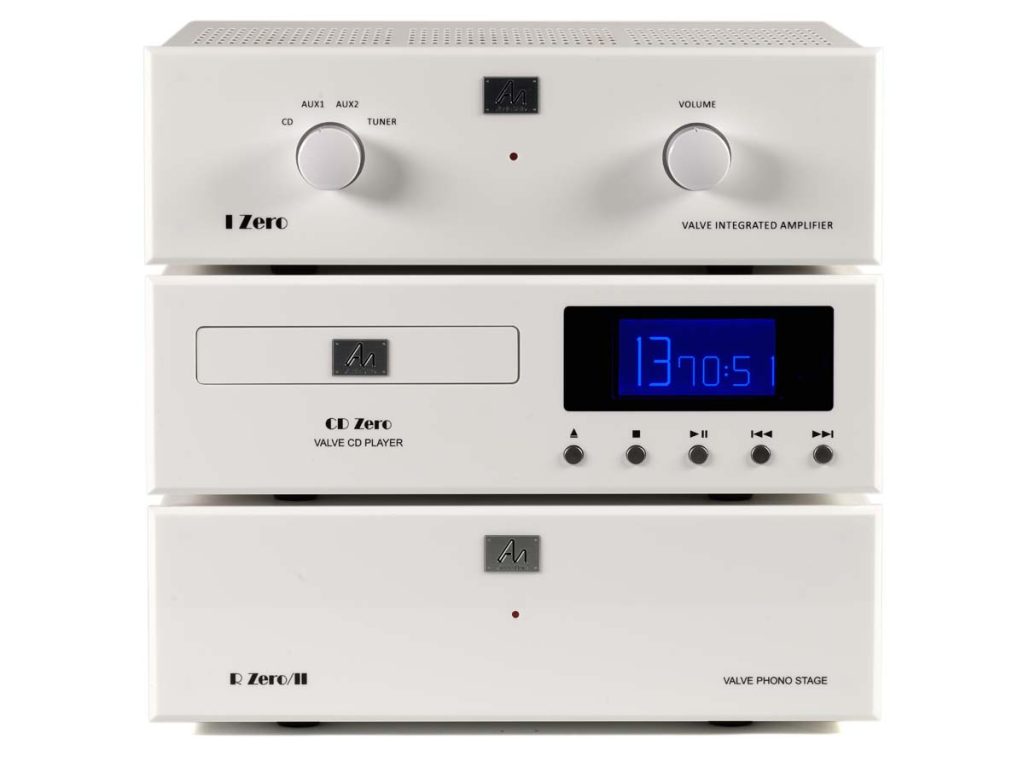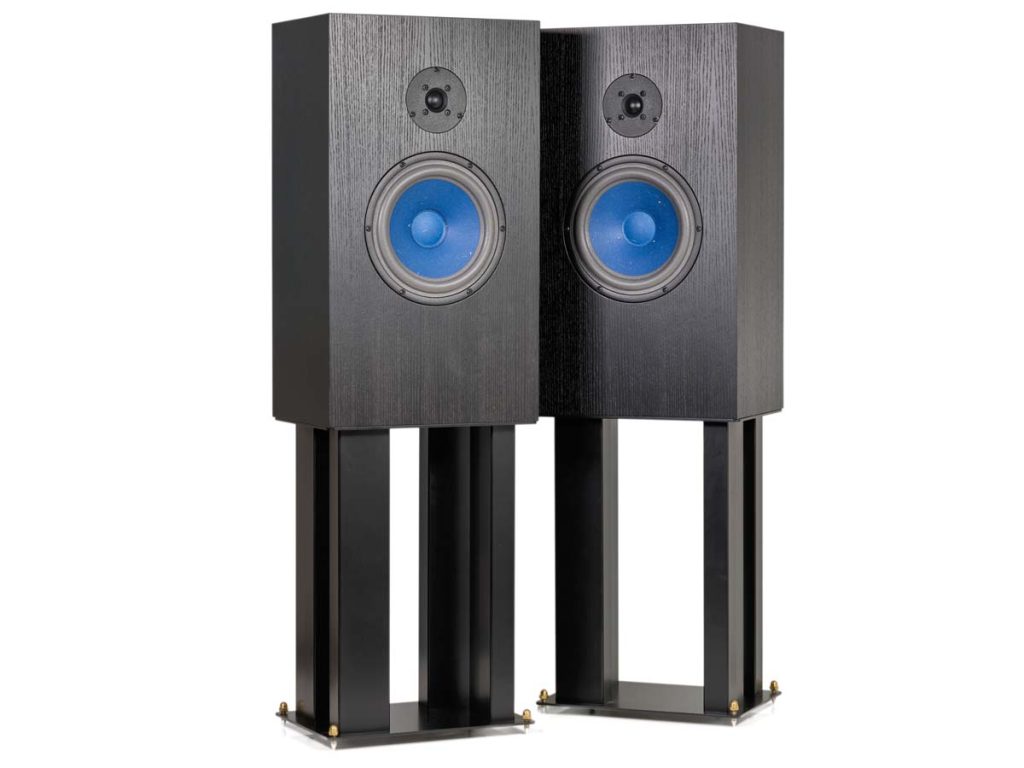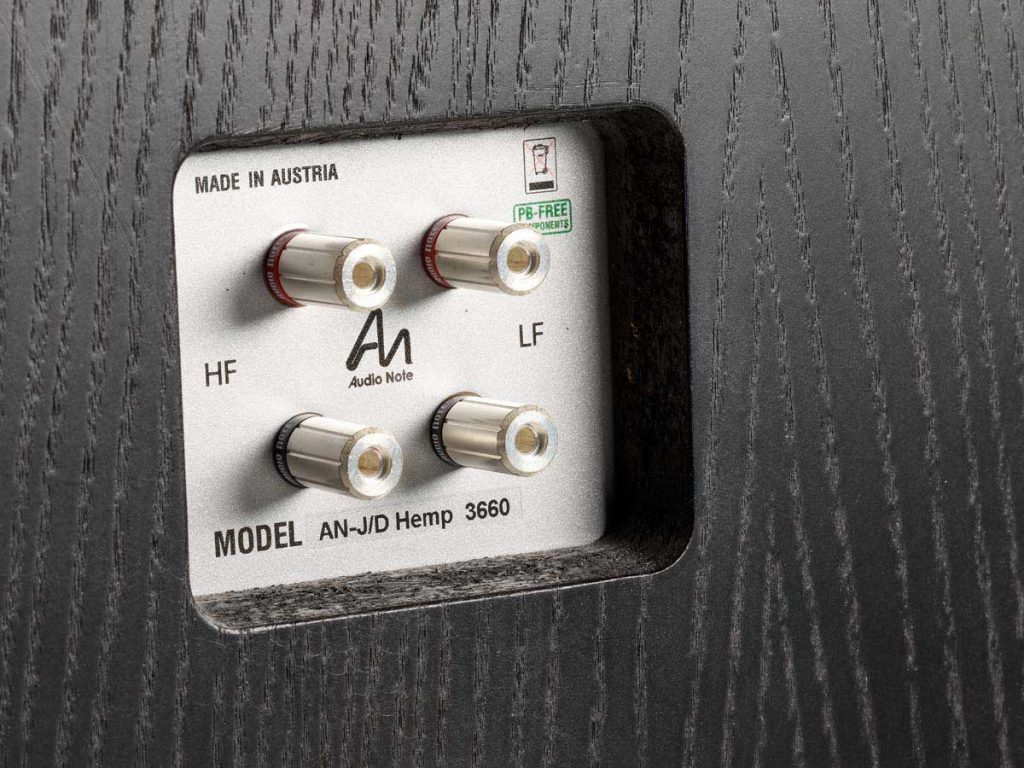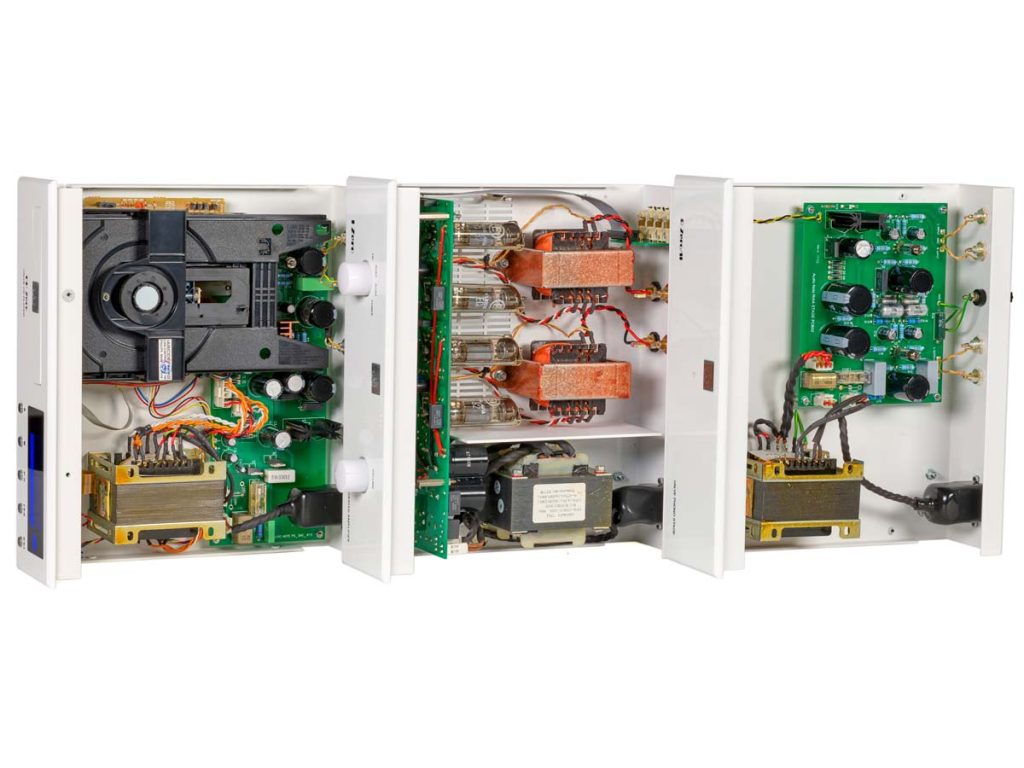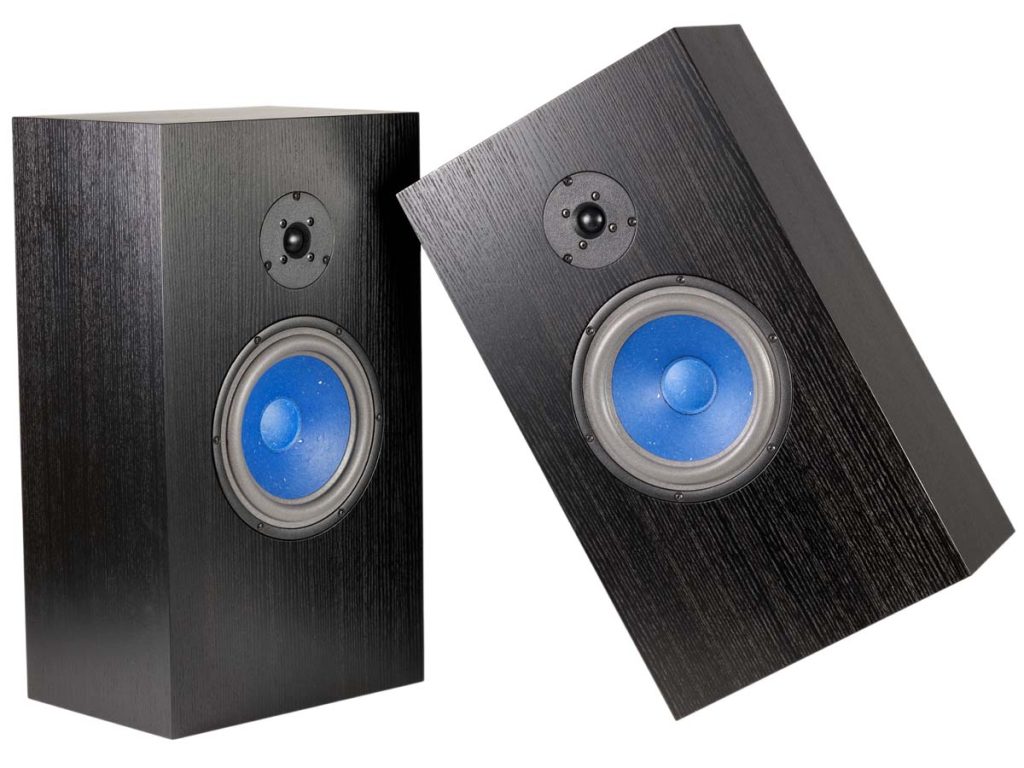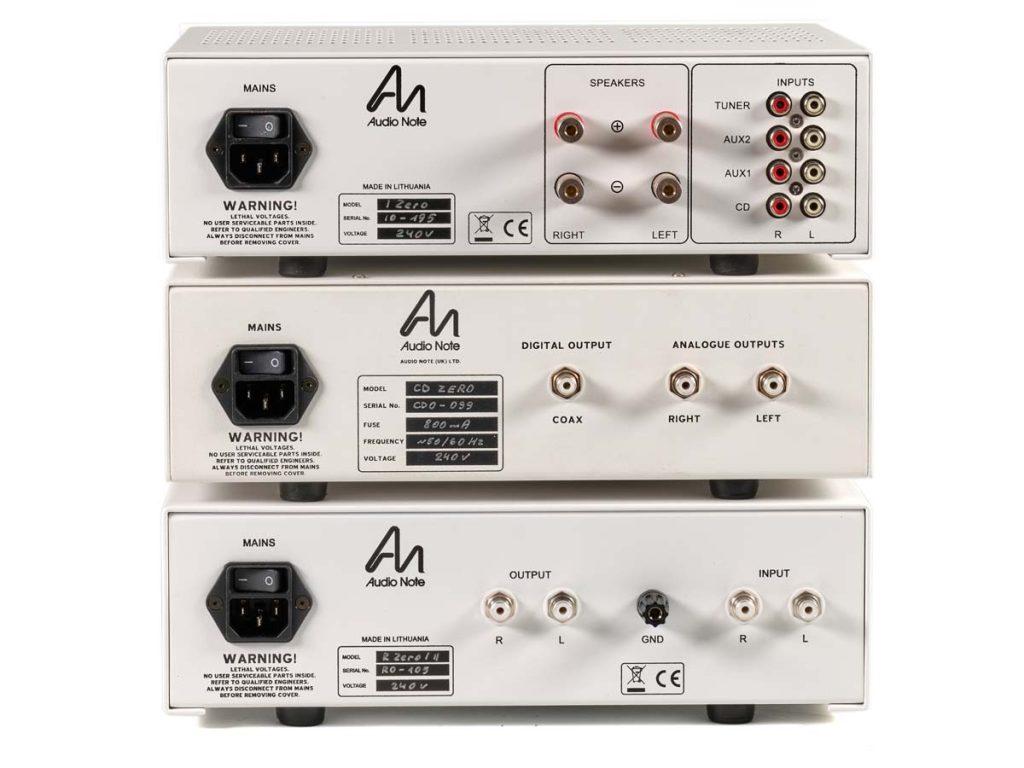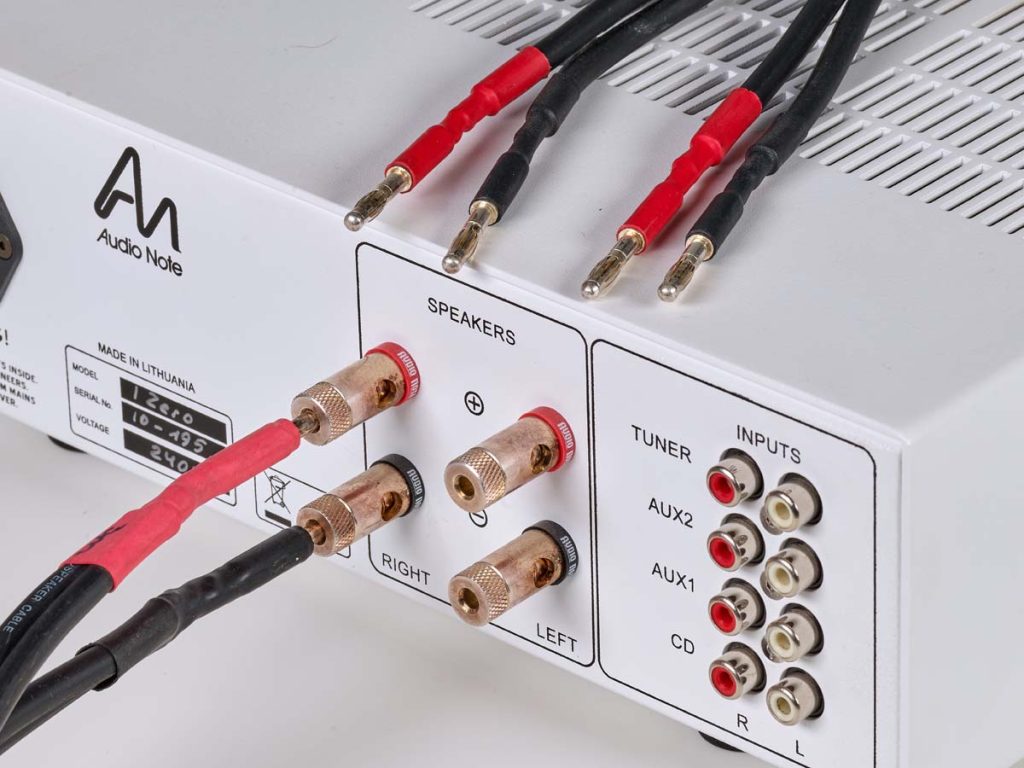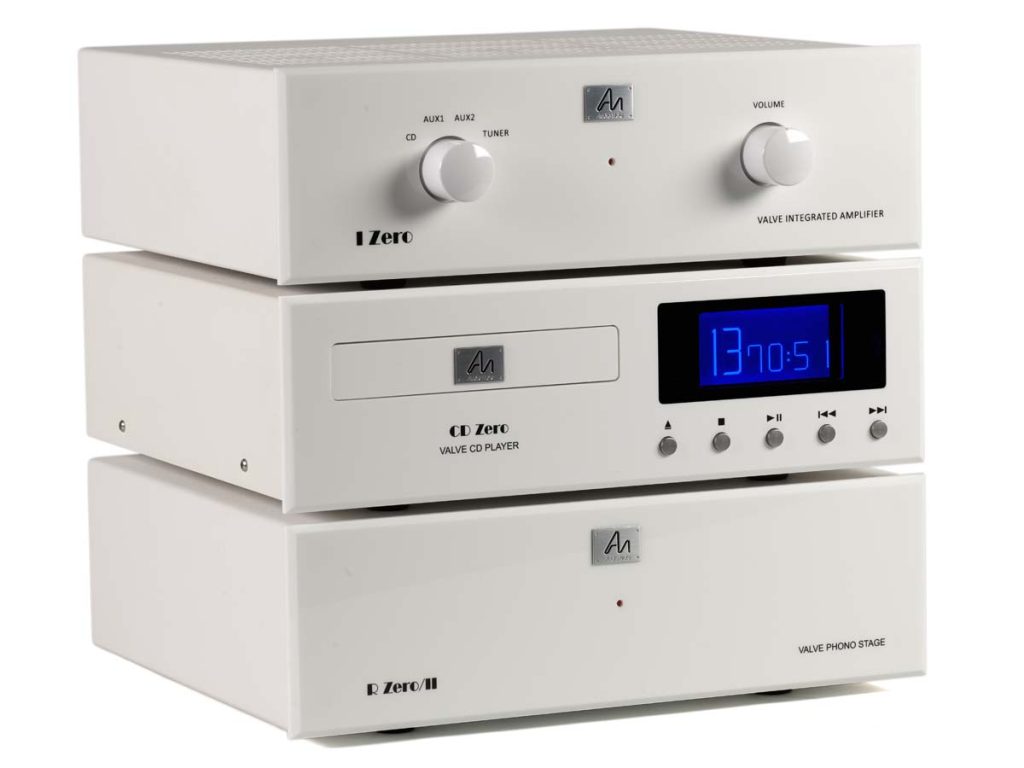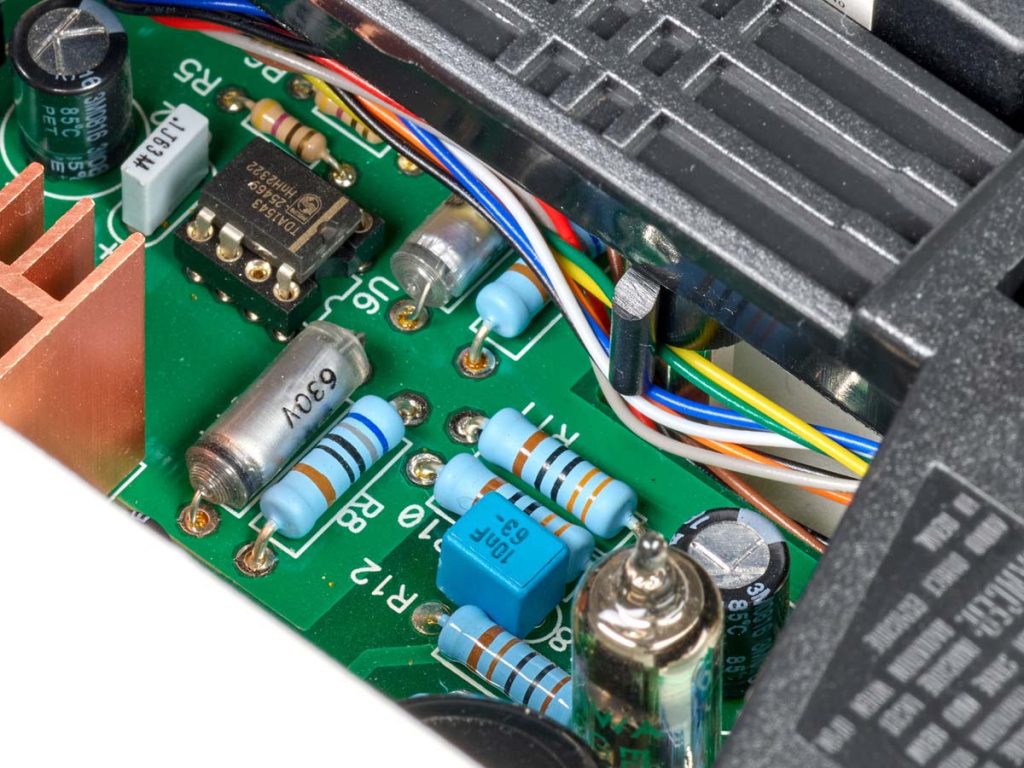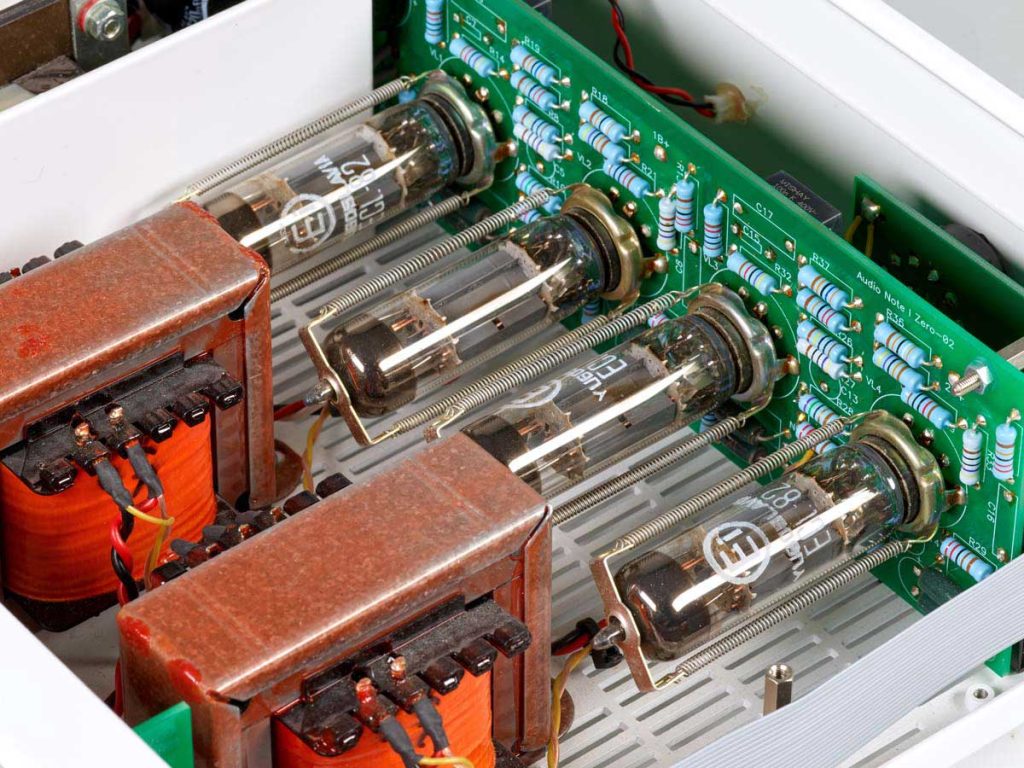Small boxes that emit big sounds: That’s the basic idea behind the Zero Chain, which aims to offer an affordable entry into Audio Note’s world (of valves).
“Aren’t they cute!” exclaimed an opera singer acquaintance of mine, only just in her early twenties, which says a great deal about about the high WAF rating inherent in Audio Note UK‘s entry-level equipment. WAF? Well, ahem, “wife acceptance factor” — in many cases, the ladies have been known to have different tastes. And those more than man-sized loudspeakers, the power amps with the dimensions of a child’s coffin, which outdo others in bringing quality sounds to your living room at home, don’t necessarily appeal to the female eye. But valve specialist Audio Note UK has developed a series that’s different: the Zero Chain.
No trace of equipment as tall as a tree. The CD Zero disc player, R Zero/II MM phono stage, and I Zero integrated amplifier all appear in that stylish, living-room-compatible, half-size format very much en vogue around here in the 1980s. My test system is white, by the way. No boring silver, no standard black — just pure wedding dress white. So high-gloss as only a carefully finished plastic surface can be. Simplicity lies at the heart of the Zeros’ design: A seamlessly integrated red LED on/off indicator light is all that adorns the front of the phono amp. This light is joined by an input selector and volume control button on the amplifier. While the finger-caressing buttons on the black version gleam in a contrasting resplendent gold, my stack carries on with the theme of white. Lending a dash of color to the CD player, and not just to its exterior, the pleasantly large and therefore easily readable display is bright blue while key controls appear in brushed aluminum. These parts enable the cute little digital player, whose centerpiece features a valve output stage with a 6111WA dual triode, to be operated even when the less than dazzlingly designed dark gray plastic remote-control unit, which falls short of looking at all premium, happens not to be at hand.
At any rate, these compact units from the UK that were devised in the Baltic states (see also our interview below) impressed me. Perhaps that’s because my first serious piece of hi-fi equipment, bought with money I received as confirmation gifts, was a cassette deck from Grundig’s now legendary Mini series. Years later, I added the matching tuner and pre-/power amp combination to that MCF 100. Provided the capacitors got a rejuvenation treatment from time to time, the miniature system definitely produces a very decent sound, even by today’s standards. Still, it wouldn’t stand a chance against Audio Note’s 2019 valve electronics. And this is true despite the UK manufacturer truly holding back from engaging in a component orgy on its entry-level offering. After all, these small white cubes earn their money from a rational reduction on their insides, too. In no way do they flaunt the fact they’re valve units. So forget about glass bulbs warmly glowing in the dark that can end up burning your fingers badly if you don’t handle them properly.
In the amplifier, four ECL82s raise the line signals of the source units to a loudspeaker-compatible level. Given a mere eight watts per channel, the speakers attached here should be pretty efficient. Because that certainly doesn’t apply to every sound transducer, Audio Note followed a logical train of thought and packed a suitable sound transducer with the pallet that arrived from Partridge Green near Brighton: The J/D Hemp is a black compact loudspeaker that rests on incredibly steady (and damn heavy) stands. And while its blue bass-midrange driver made from hemp fibers (hence the addition of “Hemp” to the name”) don’t make it a poser, it certainly is an eye-catcher.
Now back to the electronics: The amplifier resists any attempts to operate it by remote control. The four-source input selector that satisfyingly engages when using it and the volume control that operates without a scratch are crying out to be touched and turned by hand — a pleasure given the firm feel but one that nonetheless forces you to get out of your listening armchair from time to time. This dynamic is actually well worth the effort: What starts off quietly and gently can end up a series of real acoustic explosions, especially considering nobody believes me when I say there are only eight watts sine power per stereo channel. My female neighbors were long since subjected to a rude awakening, which I actually hadn’t intended to do.
The desktop-compatible system was not primarily designed to blast dance floors with loud music, even though I can operate it at really hefty volume levels without risk to the speakers but, however, with undoubtedly considerable risk to my and others’ hearing. If, for example, I let Dire Straits earn some “Money For Nothing,” the stunning passage of guitar play following the ethereal intro exhibits a surprising immediacy to it that causes me to flinch, even though I’ve known this legendary album really well for long enough. In this respect, the valve combo is in no way inferior to the best transistor amplifiers. Anything else would have surprised me. After all, the specialists in Partridge Green have extensive valve design expertise that other manufacturers will still be dreaming about for decades to come and that’s also clearly reflected in the successful design engineering from the Baltic states. I see the sound transducers as the most likely candidates for potential improvements with the recommendation, depending on the financial options, for a “keep it in the family” upgrade to models that offer a more powerful bass.
Just to be clear again: The Zero series currently represents the definitely most affordable opportunity for entering the Audio Note cosmos with a carefully matched audio chain. The phono amplifier can indeed “only” handle moving magnet (MM) cartridges, but it does this really well. AN also does matching step-up amplifiers, but their price places them beyond the entry-level category. No expense was spared in terms of the Zero’s sound quality, though. As you would expect, it unmistakably gravitates toward the sound of the big Audio Note combinations.
That is to say that the three Zero components working in tandem with the Hemps reliably produce a feel-good sound. If Audio Note does anything in the way of reproducible family characteristics, then these would include an immense wealth of timbre coupled with clearly defined spatial mapping and fine-tuning that fundamentally gravitates toward warmth.
“Valve detritus,” does not, however, stand a chance here: Voices are expressed acoustically with exactly the same precision as one would experience either with other chains (good) or live (better). That works as harmoniously with Mark Knopfler’s throaty rock voice from the Dire Straits oldie album mentioned above as it does with the clear-as-a-bell soprano of the young British baroque soprano singer Rowan Pierce, who made her solo debut in 2019 by releasing a recording of a remarkable Purcell recital under the Linn Records label.
As the months passed, the Zero chain became an integral part of my office and served me well not only as I listened to a broad cross-section of new CDs and albums — the Audio Note minis also make listening to vinyl a real pleasure. I know of just a few pieces of equipment that are able to play my keyboard of emotions as perfectly, especially when it comes to listening pleasure after a day’s work. Only as the small white blocks departed my home and headed toward the FIDELITY photo studio did I come to realize that other audio chains take a considerably more analytical approach to the reproduction of preserved sound events. More honesty may well prevail as far as other amplifiers, CD players, and phonostages are concerned.
But the question is only this: Do I actually want to ultimately have the inadequacies and faults of a recording shoved under my nose every time I listen to it? The scintillating tonal splendor of Gustav Mahler’s Eighth Symphony performed by the Hesse Broadcasting Symphony conducted by Eliahu Inbal (Denon), the emotion-stirring presence of José Carreras and Dame Kiri Te Kanawa as they let their worldclass voices shine through in their performance of Tony and Maria in Leonard Bernstein’s West Side Story (Deutsche Grammophon), and the crisp “Hoagascht“ (informal folk music event) atmosphere captured on the South Tyrolean folk trio Cordes y Butons’ 2019 CD Gimpl (Preiser/Naxos): Each finds a circumspect, skilled partner in these compact Audio Note sound boxes that amplify what is good and attractive while elegantly masking out what doesn’t work quite as well.
One of the tracks on Gimpl includes a well-crafted, pensive version of Sting’s “Fields of Gold.” If I listen to this very subtly performed pocket version of the song using the Audio Note Zero chain, the cultural transfer the three South Tyrol musicians had in mind in their elegant cover version is perceptible. Pop music full of effects is transformed into scrutinized, well-crafted, and stirring (in the best sense of the word) soul music, celebrated with solely acoustic instruments and recorded as puristically as the arrangement itself is presented. And there I found myself no longer sitting in front of a stereo system, but really close to three very musical people from my second home who are performing a gentle private concert for me that expresses all their dedication and devotion. Just an illusion, sure enough. But an incredibly perfect one. Addictive.
THE ZERO SYSTEM IS SMALLER BUT NOT INFERIOR
Andy Grove, product developer at Audio Note, on the challenge of creating a premium entry-level stereo chain.
FIDELITY: The Zero system is affordable, but certainly not “cheap,” and it exhibits many of the positive qualities we’ve come to appreciate about Audio Note products. What does it mean for an experienced high-end product designer to design an “entry-level chain” and where were cuts or compromises made?
Andy Grove: To start, one should bear in mind that more budget-priced products generally feature lower profit margins and that the manufacturer hopes to sell greater quantities on the basis of the price in order to make the product line profitable. That’s why manufacturing costs need to be lowered. The Zero system largely adheres to the philosophy that also characterizes the rest of the Audio Note portfolio and does this without sacrificing too much. Take this as an example: Where things normally start getting expensive — namely with the amplifier — we decided to reduce the output power. That means we could reduce the size and weight of the power amp section, which is expensive and complicated to produce. For this reason the Zero system is in many respects smaller than but not inferior to the other Audio Note products. And when the price of a component really mattered, we didn’t make the decision lightly. We used a TDA1543 in the DA converter instead of a AD1685 converter IC, for example.
When a piece of equipment is sold in large quantities and it’s designed to have a long product life, it doesn’t only matter how the component reacts in terms of electronics and sound, it also matters that the supply of spare parts is secured and sufficient stocks for repairs and follow-up orders are available. Furthermore, the plan with the Zero system has always been to create a system in a smaller-than-standard format — and that also has certain consequences.
Like practically all Audio Note equipment, the Zeros are also based on valve technology. Which criteria were employed to select the valves for the “minis” and are the 6111/12WA and the ECL82 used for the amplifiers bought-in components or do you manufacture them in-house?
As with all our products, we have taken the utmost care to use valves for the Zeros that not only produce a superb sound, but also do their jobs reliably. In the Zero system, we’ve used miniature valves that have military applications: The 6111WA and 6112WA “rocket” models (which, for example, have been and still are installed in guided weapons, hence the term) have long service lives, are small, and sound excellent — and we have sufficient stocks we well. The I Zero integrated amplifier uses the ECL82 triode/pentode valve, which can be easily purchased new on the world market. It also delivers a superb sound.
The R Zero phono amplifier that dovetails with the chain restricts itself to processing signals from MM cartridges for high-level input purposes. What should MC users like me buy? An MC step-up transformer? Or an Audio Note preamplifier from one of the larger equipment ranges?
Of course it’s possible to construct an MC phono preamplifier using valve technology. There are certain valve types and circuitry designs for that purpose. One alternative in this respect is, in fact, using a transistor circuit. But the R Zero was intentionally designed as a pure MM amplifier because we assume it’s used in conjunction with cartridges, as featured in Audio Note’s IQ range. Of course, it’s up to every Zero owner to decide whether he or she wants to buy an MC step-up transformer from one of our larger ranges. If your budget is very tight, then the transistor solution does the job, too.
Accompanying equipment
CD players: Mark Levinson 390s | SACD players: Marantz SA14 V1, Sony SCD 333 ES, Pioneer D6, Denon CX2 | Turntables: Clearaudio Innovation Compact, SoReal Audio Seismograph, Dr. Feickert Volare | Pickups: Clearaudio Da Vinci and Jubilee MC, Denon DL-103R | Integrated amplifiers: Marantz HD-AMP1, Mark Levinson 5805 | Preamplifiers: Mark Levinson No. 38S, Trigon SnowWhite, Marantz SC-22 | Power amplifiers: Mark Levinson No. 27, Marantz MA-22, John Curl JC3, Trigon Dwarf II | Phono amplifiers: Musical Fidelity M-VNYL, Clearaudio Basic | Loudspeakers: Infinity Kappa 7.2 Series II, MuSiCa NoVa PlethorA | Accessories: spikes and equipment mats from ViaBlue
CD player
Audio Note CD Zero
Concept: Redbook CD player with a Philips DAC TDA1543 featuring a nonoversampling digital filterless circuit | Valve complement: 6111WA miniature dual triode in the output stage | Output impedance: < 2 kΩ | Channel balance: variance < 0.25 dB | Dimensions (W/H/D): 30/10/27 cm | Weight: 3.5 kg | Warranty period: two years | Price: around €2,440
MM phonostage
Audio Note R Zero/II
Concept: Phono preamplifier for moving magnet (MM) systems with twin 6112WA valves | Dimensions (W/H/D): 30/10/27 cm | Weight: 3 kg | Warranty period: two years | Price: around €1,640
Integrated amplifier
Audio Note I Zero
Concept: Stereo integrated amplifier with four ECL82 valves, four cinch inputs, and single wire terminal | Input impedance: 100 kΩ | Input sensitivity: 400 mV | Output (6 Ω): 8 W RMS per channel | Channel balance: ±0.3 dB | Dimensions (W/H/D): 30/10/27 cm | Weight: 7 kg | Warranty period: two years | Price: around €2,430
Loudspeaker
Audio Note J/D Hemp
Concept: two-way compact loudspeakers | Nominal impedance: 6 Ω | Frequency range: 25 Hz to 23 kHz, ±6 dB | Recommended amplifier power (6 Ω): 7–150 W | Dimensions (W/H/D): 33/59/24 cm | Weight per speaker: 13 kg | Warranty period: two years | Price per pair: around €5,850 (stands around €630)
Audio Note Deutschland UG
Soltauer Str. 44
29646 Bispingen
Germany
Phone +49 5194 5050599

